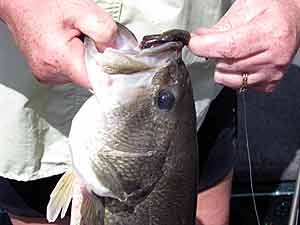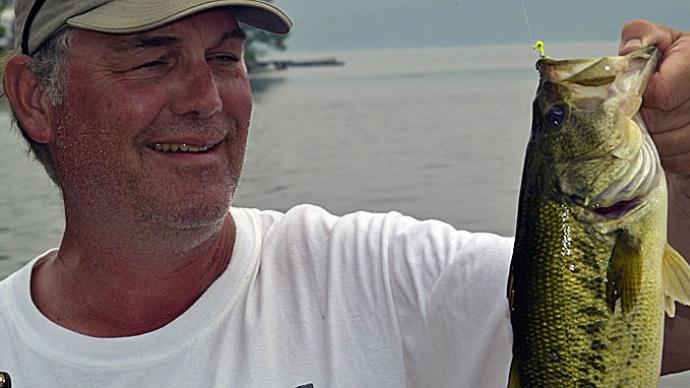
Imagine a new reality T.V. show hits the Outdoor Channel that puts a group of anglers together on an unknown lake at an undetermined time of the year to compete against each other. The ground rules are simple: each angler fishes out of the same rig type and gets only one rod, one reel, and a single lure to compete with. So what do you think most anglers would choose? If you said a plastic worm, you are probably right. In fact, according to B.A.S.S., the plastic worm has won more tournaments than any other bait since the inception of the B.A.S.S. circuit back in 1967.
The plastic worm has got to be one of the most frequently cited "go-to" baits by anglers in various situations. Perhaps this is because the plastic worm is one of the few baits that can be fished at all depths of the water column and all retrieval speeds. Perhaps it is because the plastic worm can be fished in the heaviest cover to the most barren cover to the most barren of shorelines. Or perhaps it is because the plastic worm is offered in a myriad of colors that can match almost any forage found in a particular body of water.
Whatever the case, the basic straight-tail plastic worm has spawned more variants than any other bait in history. Flukes, craws, lizards, grubs, pork chunks, tube baits, and swimbaits can all trace their lineage back to the basic plastic worm. But how did this by-product of modern chemistry make its way to the fishing world in the first place?
According to the United States Patent and Trademark Office, the first plastic worm-style bait received a patent in 1877. This rudimentary bait was made from pure rubber. Unfortunately, its stiffness, combined with the tackle of the day, this first attempt at the worm was to become nothing more than a footnote in the fishing history book. From here, though, the history of the plastic worm becomes something of a Horatio Algiers story with a McGyver twist.
The real genesis of the plastic worm occurred in post-war Middle America. The year was 1949, and machinist and avid angler, Nick Créme, was experimenting with various mixtures of vinyl in his Akron, Ohio, home. Nick made his original molds from live night crawlers and, with his wife Cosma's help, trudged the hot pots full of molten vinyl from the kitchen to the basement, where he unknowingly became the "father of hand-pouring plastics." He also became the first to add scent to his worms by adding ground-up dried night crawlers and cheese to the gooey conglomerate. Créme's first product, the Wiggle Worm, hit the market in 1951. Demand for the Wiggle Worm took off and far exceeded Créme's production capacity. Ultimately, in the 1960s, the Créme's moved their lure-making operation to Tyler, Texas. Coincidentally, "Texas rigging" of plastic worms became popular shortly after. Today, Créme's original Wiggle Worm is still in production and sold under the name "Scoundrel."
Although others in the 1950s were working with similar materials to create another plastic contraption for fishing, the next leap in the story came in 1967 when Tom Mann, an angler from Lake Eufaula, Alabama, introduced the now-famous Jelly Worm. These worms brought a new level of softness to this type of bait that had not been seen previously. This, in combination with translucent colors and the addition of scents blended directly into the plastic, took plastic worms to a new level.
The next revolution came from a small Louisiana town in the early 1970s. Up to this point, a straight-tail plastic worm was all anglers had known. A company called Mister Twister changed everything in 1972 when they introduced the Curly Tail worm and grub. The built-in action of a wavy tail combined with soft plastics proved an instant hit among anglers. Every curly tail plastic made can trace its roots directly to Mister Twister.
During this period, bass fishing was emerging into a national sport with the help of tournaments and organizations such as B.A.S.S. Bass fishing was growing in popularity at an exponential rate. Incidentally, so was the popularity of the plastic worm as different versions started sprouting up everywhere.
Rebel introduced the Ringworm in the mid-1970s. Gene Larew started to put salt in the plastics he was molding. Lindy-Little Joe, Berkley, Boone, Lunker Lure, Culprit, Red's, Bagley, and many others joined the fray. Two-tone worms, fire-tail worms, bloodline worms, worms with sparkle and flake, and scented worms started popping up in tackle shops. During this same period, the plastic worm underwent some significant mutations. The spider jig, a variation of the basic bucktail jig, appeared courtesy of Bobby Garland and one of his competitors. Larry Snyder or Twin T's. Swimbaits developed out of Mr. Twister's 1982 introduction of the Sassy Shad. Haddock Lures came out with some exciting variations on baits that could only be described as the first of the creature baits. Marv Bendlin, of Worm King started making reapers - a leech-style bait. Berkley developed the ever-popular Power Bait series of plastics. Tube jigs, plastic pork, lizards, crawdads, trailers, and every other variation of a plastic bait appeared, riding the plastic worm's success.
To unknowingly further the development of the plastic worm, many mail-order catalogs were offering kits that allowed anglers to make their own plastic worms. This led to the next generation of plastics - the hand pours.
In the late 1970s and early 1980s, custom hand pours were starting to sprout up all over the Western U.S. as anyone with a hot pot and homemade molds was pouring out of their garage. Smitty Worms, one of the first-hand pours to make it commercially, was finding its way into Western tackle shops. Companies too numerous to list have come and gone since hand pouring proved expensive and time-consuming for most back-door operators to make a living from what was basically a hobby gone wild.
Frustrated that they could not get good quality hand pours at a reasonable price, Greg and Harvey Stumpf combined their collective mechanical engineering experience and devised a solution. In 1989, Greg invested in the first robotic machine, capable of mass-producing hand-poured worms with precision and consistency. Since then, RoboWorm can also be partially credited for reintroducing the ringworm design with its famous Zipper Worm. The hundreds of knock-offs the zipper-styled baits have spawned validates the success of this lure.
Anglers, in their ingenuity, were taking advantage of using plastic worms in different fashions. Instead of the original Créme pre-rigged worm, anglers developed their methods for fishing worms more effectively. As previously mentioned, Texas rigging became one of the most accepted methods for rigging worms. It wasn't long, though, before Carolina rigging, wacky rigging, split-shotting, and other methods became popular among anglers in different regions around the U.S. Today, the latest development in the saga of the plastic worm is drop-shotting. This Japanese-born technique is a departure from traditional rigging and has become a proven fish catcher. Drop shotting is directly responsible for several victories in major tournaments in the last couple of years and is still gaining acceptance.
An industry has grown from its beginnings in Nick Créme's small Akron, Ohio basement. The Fishing Tackle Retailer's Buyer's Guide lists 84 manufacturers of plastic worms. This number is undoubtedly much higher since the publication does not consider the many smaller companies that may not have a national presence or companies that produce plastics other than worms. Nor does this consider the dozens of other companies that have profited by designing hooks, weights, tackle bags, and scents to be utilized in conjunction with plastic baits.
Why so many plastic worms? When you get right down to it, why not? A good plastic bait is a manufacturer's dream. Once the initial price of the mold has been offset, your production costs are limited to very low-cost materials. A single mold can produce hundreds of thousands of baits, and with the multitude of color variations available, a single mold design can put you in the lure business. The plastic worm's main selling point, a soft and supple action-filled form, has planned obsolescence built in by design. The softer the body material, the more likely it is to get eaten by a fish or torn off the hook. This may explain why so many bait companies are selling worms and other variants of plastic baits.
Plastic worms also offer the advantage of being economical. Three bags of worms can be purchased for about $10 or so, providing the angler with all they need for an afternoon of fishing. I know a few anglers who are scared to throw their $25 Megabass lure into stick-ups, but I don't know a single angler who wouldn't jump at the chance to throw a worm into the same tangle.
So, the next time you are out on the water and can't figure out what it will take to put fish in the boat, do what the pros do, and give a worm a try.
Reprinted with permission from Bass West Magazine




